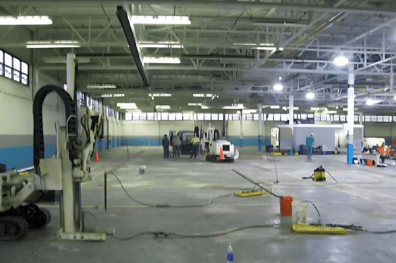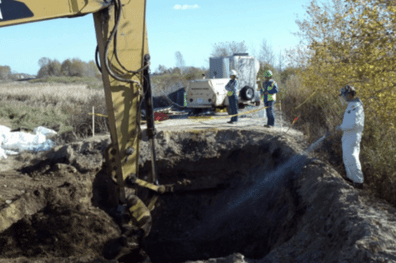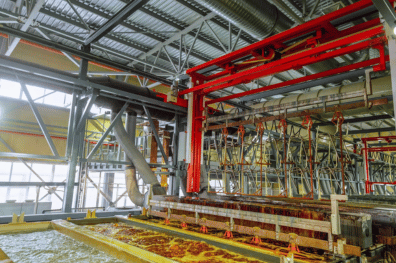A pilot study was conducted to provide information on the effectiveness of the design parameters for full-scale treatment. Pilot studies allow for the field application design to be modified or changed, if needed, before full-scale implementation.
Full scale operations took place in May of 2011 over a four-day period. Injection utilized 179 Direct Push Technology (DPT) points advanced to a target interval of 2 to 12 ft bgs covering approximately 12,000 ft2. Each injection point received approximately 170 gallons of 12% calcium polysulfide treatment chemistry with a total of 30,478 gallons during full scale operations.
The Challenge
The site required strategic planning:
- 12,000 ft² treatment area
- Multiple depth intervals (2-12 ft bgs)
- Need for design validation
- Large-scale implementation requirements
- Complex distribution needs
- Optimization requirements
The Solution: Two-Phase Implementation
The team executed a strategic approach:
- Pilot Study Phase:
- Design parameter testing
- Field application validation
- Implementation optimization
- Methodology refinement
- Success criteria establishment
- Full-Scale Implementation:
- 179 DPT injection points
- 4-day operation period
- 170 gallons per point
- 12% calcium polysulfide solution
- Total volume: 30,478 gallons
Strategic Implementation
Key operational elements included:
- Systematic point placement
- Precise depth targeting
- Consistent solution strength
- Comprehensive coverage
- Rapid deployment
Technical Specifications
Treatment details:
- Depth Range: 2-12 feet below ground
- Coverage: 12,000 ft²
- Point Spacing: Optimized from pilot
- Solution Strength: 12% calcium polysulfide
- Volume per Point: 170 gallons
Key Success Factors
Several elements contributed to project success:
- Comprehensive pilot testing
- Strategic point placement
- Optimal chemical concentration
- Efficient deployment schedule
- Quality control measures
Innovation Highlights
The project demonstrated several advantages:
- Pilot-optimized approach
- Large-scale capability
- Rapid implementation
- Effective distribution
- Validated methodology
Practical Applications
This success provides solutions for:
- Large-scale metals treatment
- Manufacturing site remediation
- Design optimization
- Implementation efficiency
- Quality control protocols
This case study shows how thorough pilot testing can lead to successful full-scale implementation of metals remediation.



